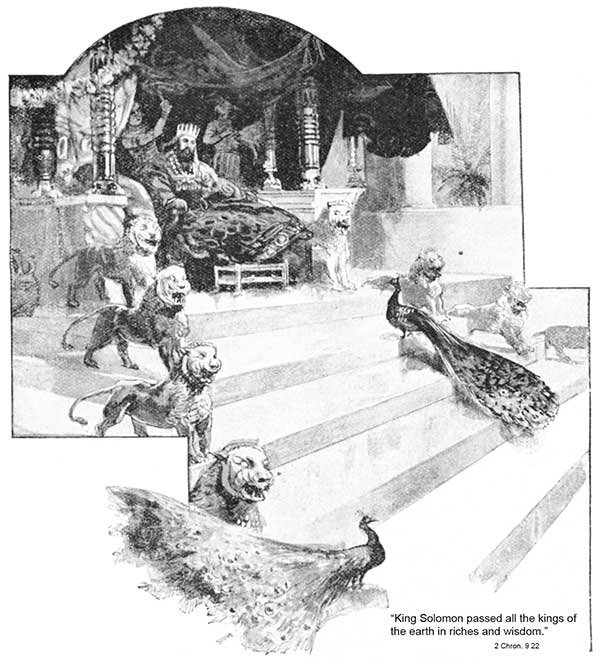
King Solomon.
King Solomon's Throne.
Aside from all of the other building projects that Solomon undertook, he also built a throne for himself the likes of which the world had never seen before or since (2 Chronicles 9:17-19 & 1 Kings 10:18-20). The throne was inlaid with ivory and overlaid with gold and it also had several unique physical features. One might say it was a great white throne.
2 Chronicles 9:17 Moreover the king made a great throne of ivory, and overlaid it with pure gold. 18 And there were six steps to the throne, with a footstool of gold, which were fastened to the throne, and arms on either side by the place of the seat, and two lions standing beside the arms. 19 And twelve lions stood there on the one side and on the other upon the six steps; there was not the like made in any kingdom. (JPS)
1 Kings 10:18 Moreover the king made a great throne of ivory, and overlaid it with the finest gold. 19 There were six steps to the throne, and the top of the throne was round behind; and there were arms on either side by the place of the seat, and two lions standing beside the arms. 20 And twelve lions stood there on the one side and on the other upon the six steps; there was not the like made in any kingdom. (JPS)
It is interesting to note that in Hebrew there are six different words for gold and two of them are used exclusively in reference to gold from Solomon's time. According to the Jewish Encyclopedia, all of the other terms for gold are used before the sixth one occurs in reference to Solomon's time, that being, the gold of Parvaim. There is a Hebrew term for gold that is only found in regard to the gold used on Solomon's throne. According to the Jewish Encyclopedia treatise on metals, this term for gold is "zahab mufaz" and it derives that designation because it looks like burning brimstone. The name may also be due in part to the place where it was obtained. If a person had a tendency to view some things as being symbolic, that person might consider the possible meaning that "zahab mufaz" might hold. It is probably unnecessary to observe some the places where burning brimstone might be encountered, but there are places where it is reputedly a common material. One of those places would be hell.
This throne will be considered in more depth in a subsequent chapter.